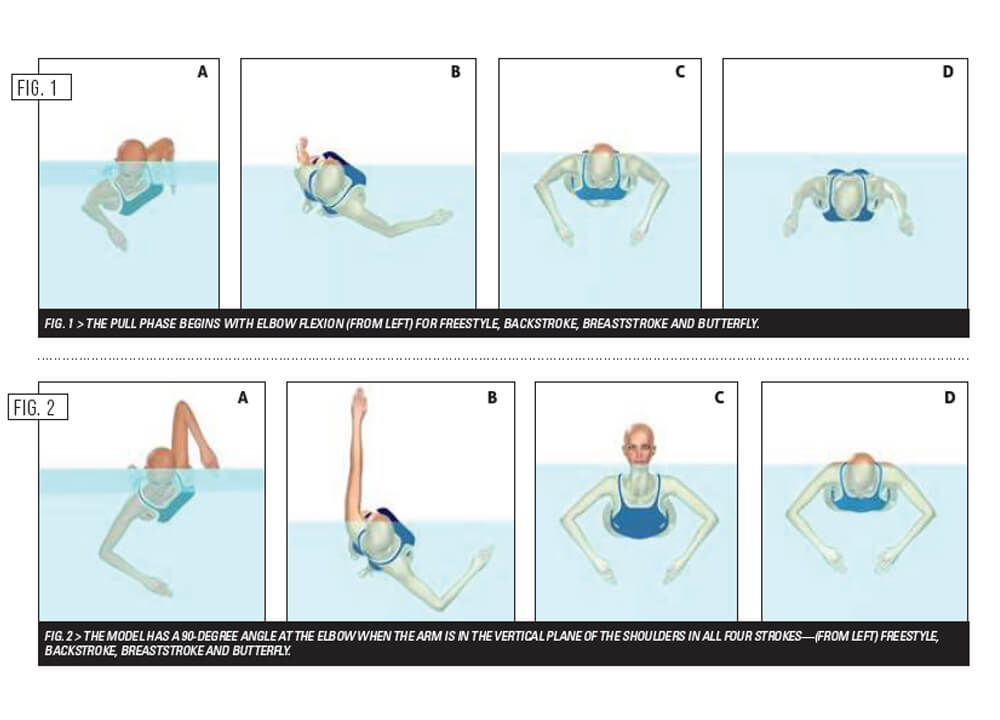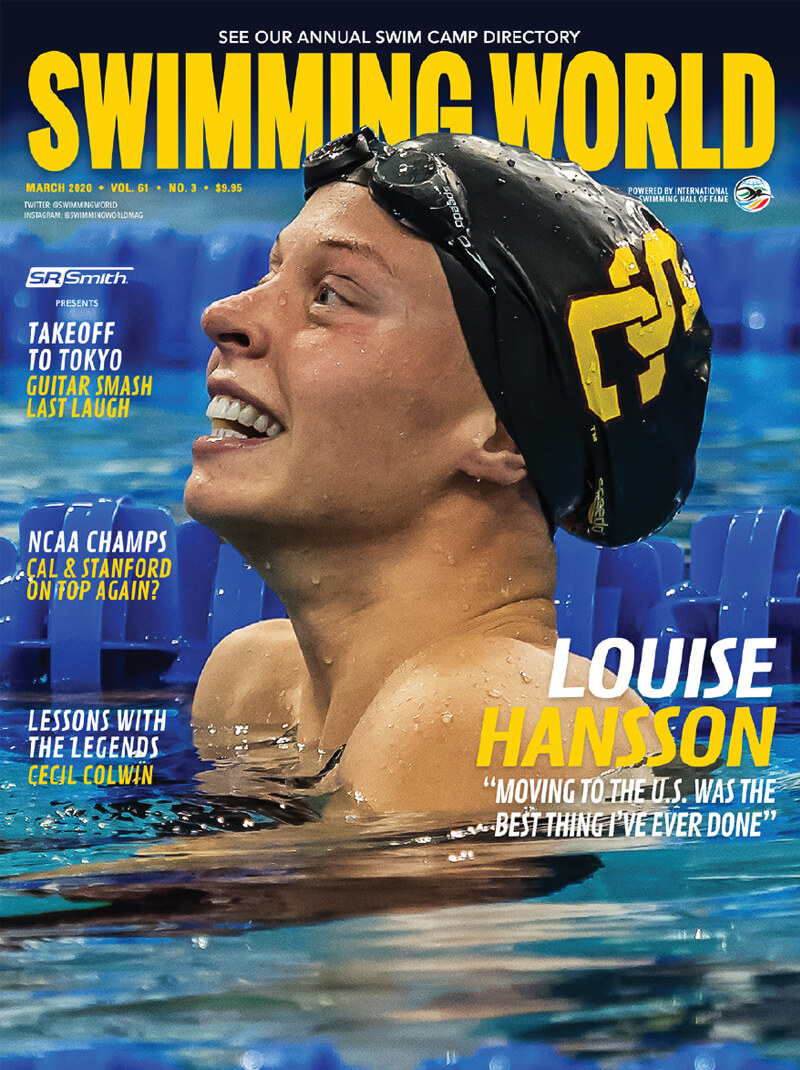Swimming World Presents “Swimming Technique Concepts: Technique Similarities Across The Four Competitive Strokes” By Rod Havriluk

Swimming Technique Concepts: Technique Similarities Across The Four Competitive Strokes
By Rod Havriluk
Although there are obvious differences in technique elements across all four competitive strokes, there are many similarities. Knowing about the similarities can help swimmers better understand specific movements and, consequently, make technique improvements more quickly.
Similarity in elbow flexion
There are technique elements common to all four strokes. For example, the underwater backward arm motion begins with elbow flexion (Fig. 1). Elbow flexion immediately and demonstrably improves leverage and, consequently, increases propulsion.
Many swimmers fail to begin the pull with elbow flexion, resulting in wasted motion and excess shoulder stress. Understanding the similarity in the beginning of the pull across all four strokes may enable a swimmer to master the skill in one stroke and then transfer that ability to another stroke.
Similarity in elbow flexion to 90 degrees
As the arms move backward to the shoulders, there is another technique element common to all four strokes. When the arms are in the vertical plane of the shoulders (Fig. 2), the angle at the elbow is 90 degrees for a fraction of a second. Of course, different arm motions in each stroke are necessary to achieve the right angle, but a swimmer might learn to flex the elbow in one stroke and transfer that ability to other strokes. For example, once a swimmer learns to achieve the elbow flexion shown for butterfly, which is fairly common (far right), he or she can use that information to achieve the elbow flexion for freestyle, which is less common (far left).
The rest of the article continues on to address:
- Similarity in head position: Free, fly, and breast
- Similarity in arm entry: Free and back
- Similarity in push phase: Free and fly
- Difference in elbow flexion: Fly and breast
To access this month’s full Swimming Technique Concept on stroke similarities,
Check out the March issue of Swimming World Magazine- Available Now!
 [ PHOTO BY PETER H. BICK ]
[ PHOTO BY PETER H. BICK ]
Get Swimming World Magazine and Swimming World Biweekly FREE When You
Become A Member of the International Swimming Hall of Fame
Want More? Subscribe With This Special 2-Year Offer!
New! 1-Year Digital Only Subscription for just $39.95 Order Now!
Non-Subscribers Can Download This Issue For Only $5.94
FEATURES
016 CATCH CAL IF YOU CAN!
by Dan D’Addona
With all their firepower and depth, Cal’s Golden Bears will be extremely difficult to catch at this year’s men’s Division I NCAAs.
020 MAY THE FOURTH BE WITH YOU
by Dan D’Addona
That’s what Stanford’s swimmers could be saying to each other, as the Cardinal appear to have what it takes to win their fourth straight women’s NCAA championship!
023 THE BEST OF BOTH WORLDS
by David Rieder
Swedish swimmer Louise Hansson never envisioned herself swimming in college in the United States. But as she prepares for this month’s women’s NCAAs, the University of Southern California senior says that moving to the U.S. was the best thing she’s ever done.
026 TAKEOFF TO TOKYO: “WE WILL SMASH THEM LIKE GUITARS”
by John Lohn
Before the men’s 400 freestyle relay at the 2000 Olympics in Sydney, American Gary Hall Jr. proclaimed the United States would “smash (the Australians) like guitars.” However, the Aussies won the race by 19-hundredths of a second, ending the U.S. streak of seven straight Olympic gold medals in the event—and 15 straight victories, counting the World Championships! In the latest installment of our “Takeoff to Tokyo” series, we venture back 20 years to what has become known as the Air-Guitar Race.
030 UPON FURTHER REVIEW…
by Andy Ross
The battle for supremacy for this year’s NCAA Division II and Division III swimming and diving titles might not be such a foregone conclusion as in previous years when Queens dominated D-II, Emory controlled women’s D-III and Denison was the talk of men’s D-III.
COACHING
010 LESSONS WITH THE LEGENDS: CECIL COLWIN
by Michael J. Stott
014 SWIMMING TECHNIQUE CONCEPTS: TECHNIQUE SIMILARITIES ACROSS THE FOUR COMPETITIVE STROKES
by Rod Havriluk
Although there are obvious differences in technique elements across all four competitive strokes, there are many similarities. Knowing about the similarities can help swimmers better understand specific movements and, consequently, make technique improvements more quickly.
040 Q&A WITH COACH BILLY DOUGHTY
by Michael J. Stott
043 HOW THEY TRAIN LUCA URLANDO
by Michael J. Stott
TRAINING
013 DRYSIDE TRAINING: STROKE STRENGTH SERIES—BACKSTROKE
by J.R. Rosania
JUNIOR SWIMMER
045 UP & COMERS: JACE LLOYD
by Shoshanna Rutemiller
COLUMNS & SPECIAL SECTIONS
008 A VOICE FOR THE SPORT 009 BEYOND THE YARDS
019 THE OFFICIAL WORD
032 2020 SWIM CAMP DIRECTORY 044 HASTY HIGH POINTERS
046 GUTTERTALK




Devin Kellett
Marie-Soleil Robinson Nadya Lefebvre Marion Barbé